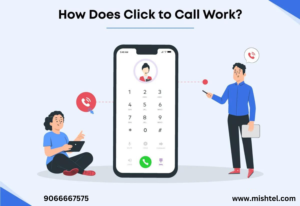
In the context of cloud telephony, “Single Click to Call” refers to a feature that enables users to initiate a phone call with a single click through a cloud-based telephony system. Cloud telephony involves using internet-based communication services to make, receive, and manage phone calls. SingleClick to Call in cloud telephony is designed to streamline the calling process and enhance user convenience.
What is a Single Click to Call?
Single Click to Call is a component that permits clients to start a call with only a solitary snap, taking out the need to dial a number or quest for contact data physically. With this innovation, organizations can furnish their clients with a consistent and easy method for interfacing with them immediately.
This component is especially gainful for versatile clients who are in a hurry and lean toward speedy collaborations. By executing SingleClick to Approach their sites or portable applications, organizations can upgrade the client experience and increment change rates.
Single Click to Call offers important bits of knowledge for organizations by following call information like call term, beginning of the call, and in any event, recording calls for quality affirmation purposes. This information can be utilized for examination and improvement systems, permitting organizations to acquire significant experiences into client conduct and inclinations.
How does Single Click to Call work?
The usefulness of Single Click to Call fluctuates relying upon the particular execution and the innovation utilized, yet here is an overall outline of how it regularly functions:
User Interface Integration:
Single Click to Call is typically incorporated into user interfaces such as websites, versatile applications, or business applications.
User Action:
The user clicks on a telephone number or an assigned call button inside the application or page.

Request to Cloud Telephony System:
At the point when the client clicks, a solicitation is shipped off the cloud communication framework.
Phone Number Verification:
The cloud telephony framework checks the telephone number to guarantee it is substantial and accurately designed.
Initiation of Call:
When the telephone number is approved, the cloud telephony framework starts a call to the predetermined number.
Call Routing and Automation:
In the background, the framework might perform different robotized errands, for example, steering the call to the suitable objective, overseeing phone message, or coordinating with other business apparatuses.
Establishing the Connection:
The cloud telephony framework lays out an association between the guest and the beneficiary.
Real-Time Communication:
Clients can take part continuously correspondence through the laid out call.
Benefits:
SingleClick to Call offers a few advantages, especially with regards to cloud telephony and business correspondence. Here are a few key benefits:
Efficiency and Convenience:
Clients can start a call with a single click, saving time and wiping out the requirement for manual dialing. This is particularly advantageous for clients on cell phones.
Improved User Experience:
Improving on the calling system upgrades the general client experience, decreasing dissatisfaction and making communication more easy to use.
Streamlined Workflows:
In business conditions, Single Tick to Call smoothes out correspondence work processes. Outreach groups, client care, and different experts can rapidly interface with clients and associates.
Increased Productivity:
By decreasing the means expected to settle on a decision, Single Click to Call adds to expanded efficiency. Workers can zero in additional on the discussion and less on the dialing system.
Reduced Errors:
Manual dialing can prompt blunders in entering telephone numbers. SingleClick to Call limits the gamble of missteps, guaranteeing that calls are coordinated to the right numbers.
Integration with Business Applications:
Many cloud communication frameworks permit combination with business applications, CRM devices, and other programming. These applications can consistently coordinate a single click-to-call feature, improving business processes with enhanced proficiency.
Real-Time Analytics:
Cloud telephony frameworks frequently give constant examination and call following. This information can be important for organizations to dissect call execution and go with informed choices.
Enhanced Customer Service:
In client care situations, Single Click to Call can furnish clients with a speedy and simple method for associating with help specialists, further developing by and large consumer loyalty.
Cost Savings:
By smoothing out correspondence cycles and diminishing the time spent on each call, organizations can accomplish cost reserve funds as far as worker time and possibly lower call costs through productive steering.
Scalability:
SingleClick to Call is versatile, making it reasonable for organizations of different sizes. Whether a private venture or a huge undertaking, the element can adjust to changing correspondence needs.
Conclusion
Single Click to Call remains as a vital component in the domain of cloud telephony, changing the manner in which people and organizations start calls. By offering a smoothed out and effective way to deal with correspondence, this element delivers various advantages.
The primary benefit lies in the straightforwardness and comfort it gives. With simply a single click, clients can quickly start a call, taking out the requirement for manual dialing and fundamentally diminishing the time expected to interface. This proficiency improves client experience as well as adds to expanded efficiency in different expert settings.


